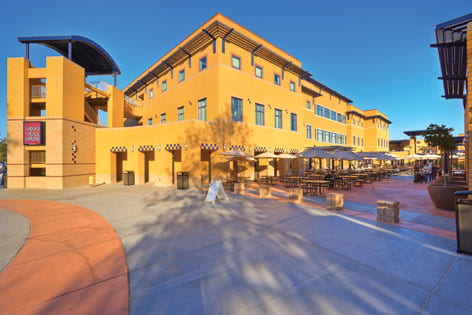Student Center design turns green to gold
UC Irvine Student Center earns kudos for its Earth-friendly design and construction, and it’s healthy for students, too.

People relaxing in UC Irvine’s new Student Center may be oblivious to how fly ash in the concrete and low-VOC carpet make it a healthier and more Earth-friendly place to hang.
But across campus in Design & Construction Services, there’s more than a little pride in the attention to sustainability that recently earned the Student Center a Leadership in Energy and Environmental Design gold certification from the U.S. Green Building Council.
Jim Brittell and Richard Demerjian try to pretend it’s all in a day’s work, but their eyes light up as they discuss the land use, water efficiency, local and recycled materials, indoor environmental quality and innovative design that made UCI’s the first student center in the state to win gold certification.
“When I look at the Student Center, I see a symbol of UCI’s commitment to sustainability and a reduction in our carbon footprint,” says Brittell, a quality assurance architect who managed the expansion project.
Demerjian, Campus & Environmental Planning director, adds: “I see a building that is less expensive to operate and healthier for occupants.”
Among the Student Center’s “green” features:
- Reflective roofing that makes the building less expensive to cool.
- Waterless urinals in the men’s rooms and other plumbing fixtures that use 42 percent less water than conventional systems.
- Access to public transit and UCI’s own shuttle system, along with use of recycled water for irrigation.
- Paint and carpet that emit low levels of volatile organic compounds.
And that fly ash in the concrete?
“Fly ash is a waste byproduct of burning coal for electricity,” Brittell explains. “When you mix it with concrete, it makes the concrete denser, stronger and more water-resistant. So we get a better product by recycling a waste product.”
Overall, he adds, recycled materials were used in 19 percent of the Student Center, including its floors and ceilings.
The campus’s green building and sustainable transportation programs, academic research in alternative energy technologies, and curricular commitment to sustainability helped contribute points toward the gold certification, too. Still, it was no slam dunk. The original design requirement was to meet LEED Certified level.
“It was only through the extraordinary efforts of the contractors, designers and university staff that the project was able to attain the gold rating,” Brittell says. “It was a long, long process, and it turned out well.”